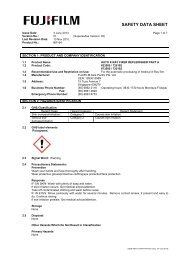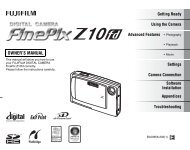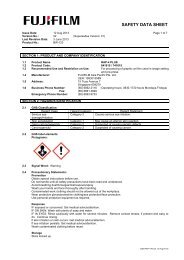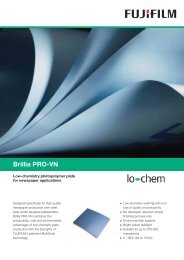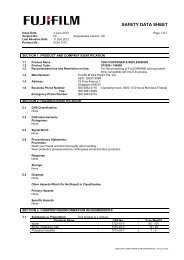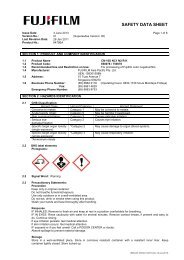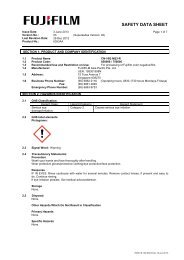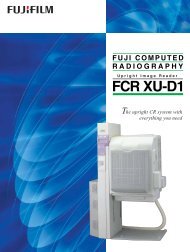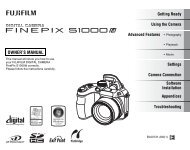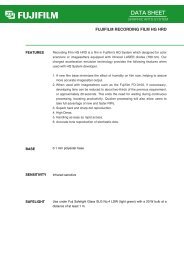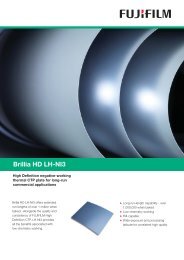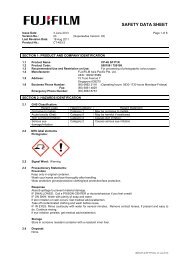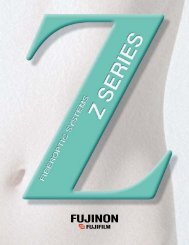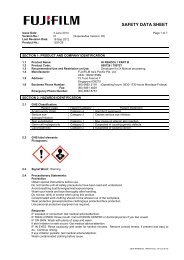CN-16L N1-CR PART C - Fujifilm
CN-16L N1-CR PART C - Fujifilm
CN-16L N1-CR PART C - Fujifilm
Create successful ePaper yourself
Turn your PDF publications into a flip-book with our unique Google optimized e-Paper software.
SAFETY DATA SHEET<br />
Issue Date: 3 June 2013 Page 1 of 7<br />
Version No.: 02 (Supersedes Version: 01)<br />
Last Revision Date: 21 Jan 2013<br />
Product No.: 6456AC<br />
SECTION 1: PRODUCT AND COMPANY IDENTIFICATION<br />
1.1 Product Name <strong>CN</strong>-<strong>16L</strong> <strong>N1</strong>-<strong>CR</strong> Part C<br />
1.2 Product Code: 850067 / 750069<br />
1.3 Recommended Use and Restriction on Use: For processing of <strong>Fujifilm</strong> color negative/film.<br />
1.4 Manufacturer: FUJIFILM Asia Pacific Pte. Ltd.<br />
UEN: 199301558N<br />
1.5 Address: 15 Tuas Avenue 7<br />
Singapore 639270<br />
1.6 Business Phone Number: (65) 6862 2116 (Operating hours: 0830-1730 hours Mondays-Fridays)<br />
Fax: (65) 6861 4829<br />
Emergency Phone Number: (65) 6863 8753<br />
SECTION 2: HAZARDS IDENTIFICATION<br />
2.1 GHS Classification:<br />
Hazard Class Hazard Category Hazard Statement<br />
Corrosive to metals Category 1 May be corrosive to metals.<br />
Acute toxicity (Oral): Category 4 Harmful if swallowed.<br />
Skin corrosion/irritation: Category 2 Causes skin irritation.<br />
Serious eye<br />
damage/irritation:<br />
Category 2 Causes serious eye irritation.<br />
Skin sensitization: Category 1 May cause an allergic skin reaction.<br />
Specific target organ toxicity<br />
(repeated exposure):<br />
Category 2 May cause damage to organs.<br />
2.2 GHS label elements<br />
Pictograms:<br />
2.2 Signal Word: Warning<br />
2.3 Precautionary Statements:<br />
Prevention<br />
Keep only in original container.<br />
Do not breathe dust/fume/gas/mist/vapours/spray.<br />
Wash your hands and face thoroughly after handling.<br />
Do not eat, drink or smoke when using this product.<br />
Contaminated work clothing should not be allowed out of the workplace.<br />
Wear protective gloves, clothing and eye/face protection.<br />
Response<br />
IF SWALLOWED: Rinse mouth. Call a POISON CENTER or doctor if you feel unwell.<br />
IF IN EYES: Rinse cautiously with water for several minutes. Remove contact lenses, if present and easy to<br />
do. Continue rinsing.<br />
If eye irritation persists: Get medical attention.<br />
IF ON SKIN: Wash with plenty of soap and water. If skin irritation or rash occurs: Get medical attention.<br />
Take off contaminated clothing and wash before reuse.<br />
Get medical attention if you feel unwell.<br />
Absorb spillage to prevent material damage.<br />
Storage<br />
Store in corrosive resistant container with a resistant inner liner.<br />
(SDS-<strong>CN</strong>-<strong>16L</strong> <strong>N1</strong>-<strong>CR</strong> <strong>PART</strong> C.doc, 06-Jun-2013)
SAFETY DATA SHEET<br />
Issue Date: 3 June 2013 Page 2 of 7<br />
Version No.: 02 (Supersedes Version: 01)<br />
Last Revision Date: 21 Jan 2013<br />
Product No.: 6456AC<br />
2.4 Disposal:<br />
Dispose of contents/containers in accordance with local/national regulations.<br />
Other Hazards Which Do Not Result in Classification<br />
Primary Hazards<br />
None.<br />
Specific Hazards<br />
None.<br />
SECTION 3: COMPOSITION/INFORMATION ON INGREDIENTS<br />
3.1 Substance or Preparation: This product is a mixture.<br />
Chemical Name CAS No. % by Weight<br />
Water 7732-18-5 80 -100<br />
p-phenylenediamine derivative 25646-77-9 7 - 15<br />
SECTION 4: FIRST-AID MEASURES<br />
4.1 Inhalation:<br />
Move the victim into the fresh air, keep him or her warm and quiet, cover with a blanket, and send for<br />
immediate medical assistance.<br />
If the victim is not breathing or is breathing very weakly, loosen his or her clothing in order to secure an<br />
airway and begin artificial respiration.<br />
If the casualty is unconscious, but breathing, or is conscious but experiencing breathing difficulties, the<br />
provision of oxygen is effective. It is preferable to do this under medical supervision.<br />
No medicine other than oxygen may be dispensed. No food may be given to the victim without the<br />
physician’s direction.<br />
4.2 Skin Contact:<br />
If it is spilled on the skin, wash off with copious amounts of soap and water.<br />
Remove the contaminated clothes, shoes, etc., immediately. Cut the clothing off if necessary.<br />
Subsequently, rinse the skin with cool or tepid running water for at least 30 minutes.<br />
Immediate medical attention is required.<br />
4.3 Eye Contact:<br />
If a contact lens is in place, remove it and wash the eye with warm running water for at least 15 minutes,<br />
unless the lens is firmly attached to the eye. Use physiological saline if it is readily available.<br />
Do not stop rinsing the eye. During the rinse, open the eyelid with your fingers so that water can reach<br />
under the eyelid. Send for an ophthalmologist immediately. An ophthalmological examination is<br />
absolutely essential because the possibility exists that there may be after effects even if there are no<br />
immediate pain or vision problems.<br />
4.4 Ingestion:<br />
If it is swallowed, call a doctor immediately.<br />
Do not attempt to make the victim vomit.<br />
Rinse the mouth out thoroughly with water.<br />
Give the casualty 1-2 glasses of water to dilute the quantity of the substance in the stomach. (If milk is<br />
readily available, this can be given to the casualty after the water.)<br />
If the victim vomits of his/her own accord, bend his/her body so as to prevent vomit from entering the<br />
lungs. After vomiting, allow the victim to drink more water. Keep the victim warm and send for a doctor<br />
immediately and show SDS or label.<br />
4.5 Likely Acute or Delayed:<br />
None.<br />
(SDS-<strong>CN</strong>-<strong>16L</strong> <strong>N1</strong>-<strong>CR</strong> <strong>PART</strong> C.doc, 06-Jun-2013)
SAFETY DATA SHEET<br />
Issue Date: 3 June 2013 Page 3 of 7<br />
Version No.: 02 (Supersedes Version: 01)<br />
Last Revision Date: 21 Jan 2013<br />
Product No.: 6456AC<br />
4.6 Note to Physician:<br />
None.<br />
4.7 Protection of First-Aid Providers:<br />
First-aid personnel should wear personal protection equipment when assisting the casualty.<br />
SECTION 5: FIRE-FIGHTING MEASURES<br />
5.1 Suitable Fire-Extinguishing Media:<br />
Foam (alcohol-resistant foam), powder, and carbon dioxide are effective fire-extinguishing agents.<br />
5.2 Unsuitable Extinguishing Media:<br />
None under normal conditions.<br />
5.3 Hazardous Combustion Products:<br />
Carbon oxides, nitrogen oxides.<br />
5.4 Special Protective Actions for Fire Fighters:<br />
Cool the container(s) surface that is exposed to fire by spraying the surface with water.<br />
When fighting the fire, wear protective equipment (i.e., respiratory masks, self contained breathing<br />
apparatus, chemical protection suit, gloves, boots, goggles, mask, etc.) as needed to avoid inhaling and/or<br />
skin contact with the chemical substance. Extinguish from the upwind direction.<br />
SECTION 6: ACCIDENTAL RELEASE MEASURES<br />
6.1 Personal Precautions, Protective Equipment, and Emergency Measures:<br />
Wear protective equipment (i.e., respiratory masks, self contained breathing apparatus, chemical<br />
protection suit, gloves, boots, goggles, mask, etc.) as needed to avoid inhaling and/or skin contact with the<br />
chemical and/or vapours, if any. Work upwind, if possible.<br />
See Section 8 of this SDS for Personal Protective Equipment.<br />
6.2 Environmental Precautions:<br />
Do not allow to enter drains, sewers or water courses.<br />
The chemical substance in question should not be released into the environment (water, soil).<br />
6.3 Spill Containment and Cleaning Up:<br />
Minor Spills<br />
Avoid chemical contact by using personal protective equipment.<br />
Clean up spills immediately.<br />
Contain and absorb spill with sand, earth or other suitable absorbent material.<br />
Place spilled material in clean, dry, sealable, labelled container for disposal.<br />
Major Spills<br />
Clear area of personnel and move upwind.<br />
Call SCDF or local Fire Brigade.<br />
Wear full body protective clothing with respiratory masks (including self contained breathing apparatus).<br />
Prevent, by any means available, spillage from entering drains or water course.<br />
Stop leak if safe to do so.<br />
Contain spill with sand, earth or other suitable absorbent material.<br />
Collect recoverable product into labelled containers for recycling.<br />
Neutralise/decontaminate residue.<br />
Collect solid residues and seal in labelled drums for disposal.<br />
Wash area and prevent runoff into drains.<br />
After clean up operations, decontaminate and launder all protective clothing and equipment before storing<br />
and re-using.<br />
If contamination of drains or waterways occurs, advise local Environmental Agency or Authority.<br />
(SDS-<strong>CN</strong>-<strong>16L</strong> <strong>N1</strong>-<strong>CR</strong> <strong>PART</strong> C.doc, 06-Jun-2013)
SAFETY DATA SHEET<br />
Issue Date: 3 June 2013 Page 4 of 7<br />
Version No.: 02 (Supersedes Version: 01)<br />
Last Revision Date: 21 Jan 2013<br />
Product No.: 6456AC<br />
SECTION 7: HANDLING AND STORAGE<br />
7.1 Precautions for Safe Handling:<br />
Limit all unnecessary personal contact.<br />
Wear protective clothing when risk of exposure occurs.<br />
Use in a well-ventilated area.<br />
Avoid contact with incompatible materials.<br />
When handling, DO NOT eat, drink or smoke.<br />
Keep containers securely sealed when not in use.<br />
Avoid physical damage to containers.<br />
Always wash hands with soap and water after handling.<br />
Work clothes should be laundered separately.<br />
Use good occupational work practice.<br />
Atmosphere should be regularly checked against established exposure standards to ensure safe working<br />
conditions are maintained.<br />
7.2 Conditions for Safe Storage:<br />
Store in original containers.<br />
Keep containers securely sealed.<br />
Store in a cool, dry, well-ventilated area.<br />
Keep out of reach of children.<br />
Store away from incompatible materials and foodstuff containers.<br />
Protect containers against physical damage and check regularly for leaks.<br />
SECTION 8: EXPOSURE CONTROLS/PERSONAL PROTECTION<br />
8.1 Control Parameters/Occupational Exposure Limits:<br />
Ingredient CAS No. PEL/OEL Source<br />
p-phenylenediamine derivative 25646-77-9 Not established Not established<br />
8.2 Appropriate Engineering Controls:<br />
Local exhaust ventilation usually required. If risk of overexposure exists, wear approved respirator.<br />
8.3 Personal Protective Equipment:<br />
Use the following protective equipment as needed:<br />
Respiratory Protection: Self contained breathing apparatus.<br />
Eye Protection: Wear approved safety goggles.<br />
Hand Protection: Wear protective gloves. Nitrile gloves are recommended, but be aware that the liquid<br />
may penetrate the gloves. Frequent change is advisable. Suitable gloves can be recommended by the<br />
glove supplier.<br />
Skin Protection: Apron and long sleeves are recommended. Wear suitable protective clothing.<br />
Hygiene Measures: Always observe good personal hygiene measures, such as washing after handling<br />
the material and before eating, drinking, and/or smoking. Routinely wash work clothing and protective<br />
equipment to remove contaminants.<br />
SECTION 9: PHYSICAL AND CHEMICAL PROPERTIES<br />
9.1 Appearance Physical State: Clear liquid<br />
9.2 Colour: Reddish brown<br />
9.3 Odour: Sulphurous<br />
9.4 Odour Threshold: Not applicable<br />
9.5 Property Value Notes<br />
Melting Point 0 C<br />
Boiling Point 100 C<br />
Flash Point Not applicable (Not flammable) Closed cup<br />
Explosive Limit Not applicable Lower limit<br />
Explosive Limit Not applicable Upper limit<br />
Vapour Pressure Not available mmHg at 20 C<br />
(SDS-<strong>CN</strong>-<strong>16L</strong> <strong>N1</strong>-<strong>CR</strong> <strong>PART</strong> C.doc, 06-Jun-2013)
SAFETY DATA SHEET<br />
Issue Date: 3 June 2013 Page 5 of 7<br />
Version No.: 02 (Supersedes Version: 01)<br />
Last Revision Date: 21 Jan 2013<br />
Product No.: 6456AC<br />
Vapour Density Not applicable Air=1<br />
Relative Density 1.049 25 C<br />
Solubility in Water Completely soluble Water at 20 C<br />
Solubility (Other) Not applicable<br />
Partition Coefficient: n-octanol/water Not applicable<br />
Viscosity Not applicable (like water)<br />
pH 2.30 25 C<br />
Evaporation Rate Not applicable Butyl Acetate = 1<br />
Flammability (Solid, Gas) Not applicable<br />
Auto-Ignition Temperature Not applicable (Not flammable)<br />
Decomposition Temperature Unknown<br />
SECTION 10: STABILITY AND REACTIVITY<br />
10.1 Reactivity/Incompatible Materials:<br />
Strong alkali, strong oxidizing agents.<br />
10.2 Chemical Stability:<br />
Stable under normal temperature and pressure.<br />
10.3 Possibility of Hazardous Reaction:<br />
Hazardous polymerisation will not occur.<br />
10.4 Conditions to Avoid:<br />
Freezing. Protect against direct sinlight.<br />
10.5 Hazardous Decomposition Products:<br />
Carbon oxides, nitrogen oxides.<br />
SECTION 11: TOXICOLOGICAL INFORMATION<br />
11.1 Acute Toxicity on Product Mixture:<br />
Oral LD50 Rat (Slc:Wister) 1018 mg/kg<br />
Dermal LD50 No data available.<br />
Inhalation LC50 No data available.<br />
11.2 Acute Toxicity on Ingredients:<br />
Chemical Name CAS No. Acute Oral<br />
(LD50 mg/kg)<br />
Test Animal<br />
p-phenylenediamine derivative 25646-77-9 400 Rat<br />
11.3 Skin Corrosion/Irritation:<br />
Causes skin irritation (Primary irritation index: 2.50, Test animal: Japanese rabbit).<br />
11.4 Serious Eye Damage/Irritation:<br />
Causes serious eye irritation (Primary Eye Irritation Index, Single ocular: 8.00, Test animal: Japanese<br />
rabbit).<br />
11.5 Respiratory Organ or Skin Sensitisation:<br />
May cause an allergic skin reaction.<br />
11.6 Germ Cell Mutagenicity:<br />
None.<br />
11.7 Carcinogenicity:<br />
None.<br />
(SDS-<strong>CN</strong>-<strong>16L</strong> <strong>N1</strong>-<strong>CR</strong> <strong>PART</strong> C.doc, 06-Jun-2013)
SAFETY DATA SHEET<br />
Issue Date: 3 June 2013 Page 6 of 7<br />
Version No.: 02 (Supersedes Version: 01)<br />
Last Revision Date: 21 Jan 2013<br />
Product No.: 6456AC<br />
11.8 Reproductive Toxicity:<br />
None.<br />
11.9 Specific Target Organ Toxicity:<br />
May cause damage to organs through prolonged or repeated exposure.<br />
11.10 Aspiration Hazard<br />
Not applicable.<br />
SECTION 12: ECOLOGICAL INFORMATION<br />
12.1 Ecotoxicity of Product Mixture:<br />
No data available.<br />
12.2 Ecotoxicity on Ingredients:<br />
Chemical Name CAS No. Fish Toxicity Marine Organism<br />
p-phenylenediamine derivative 25646-77-9 Not established Not established<br />
12.3 Persistence and Degradability:<br />
No data on possible environmental effects have been found.<br />
12.4 Bioaccumulative Potential:<br />
No data available on bioaccumulation.<br />
12.5 Mobility:<br />
The product is water soluble and may spread in water systems.<br />
SECTION 13: DISPOSAL CONSIDERATIONS<br />
13.1 Disposal Method in Singapore:<br />
Dispose off in accordance to the Environmental Public Health (Toxic Industrial Waste) Regulations under<br />
the Environmental Protection and Management Act (EPMA).<br />
13.2 Disposal Method Overseas:<br />
Dispose off in accordance with all applicable local or national regulations.<br />
SECTION 14: TRANSPORT INFORMATION<br />
14.1 Land (ADR):<br />
UN Number: 3265<br />
Class: 8, Corrosive<br />
Subsidiary Risk: None<br />
Packing Group: III<br />
Proper Shipping Name: Corrosive L iquid, Acidic, Organic, N.O.S.. (organic amine sulphate)<br />
14.2 Sea (IMDG):<br />
UN Number: 3265<br />
Class: 8, Corrosive<br />
Subsidiary Risk: None<br />
Packing Group: III<br />
Proper Shipping Name: Corrosive L iquid, Acidic, Organic, N.O.S.. (organic amine sulphate)<br />
Marine Pollutant (Yes/No): No<br />
Packing Instruction: P001 / LP01<br />
EmS (Emergency Schedule): F-A, S-B<br />
Limited Quantity: 5L<br />
Further Information: Do not allow any contact with light metals - danger of corrosion.<br />
(SDS-<strong>CN</strong>-<strong>16L</strong> <strong>N1</strong>-<strong>CR</strong> <strong>PART</strong> C.doc, 06-Jun-2013)
SAFETY DATA SHEET<br />
Issue Date: 3 June 2013 Page 7 of 7<br />
Version No.: 02 (Supersedes Version: 01)<br />
Last Revision Date: 21 Jan 2013<br />
Product No.: 6456AC<br />
14.3 Sea (Annex II of MARPOL 73/78 and the IBC Code):<br />
Pollution Category: Not applicable<br />
Ship Type: Not applicable<br />
Product Name: Not applicable<br />
14.4 Air (IATA):<br />
UN Number: 3265<br />
Class: 8, Corrosive<br />
Subsidiary Risk: None<br />
Packing Group: III<br />
Proper Shipping Name: Corrosive L iquid, Acidic, Organic, N.O.S.. (organic amine sulphate)<br />
Label(s): Corrosive<br />
Passenger and cargo aircraft: Packing instruction 818 max. 5L<br />
Cargo aircraft only: Packing instruction 820 max. 60L<br />
Further Information: Do not allow any contact with light metals - danger of corrosion.<br />
14.5 Special Precautions:<br />
None.<br />
SECTION 15: REGULATORY INFORMATION<br />
15.1 Applicable Singapore Regulations:<br />
Workplace Safety and Health Act & Workplace Safety and Health (General Provisions) Regulations:<br />
This product is subject to the SDS, labelling, PEL and other requirements in the act/regulation.<br />
Environmental Protection and Management Act & Environmental Protection and Management (Hazardous<br />
Substances) Regulations:<br />
This product is subject to the requirements in the act/regulation.<br />
Maritime and Port Authority of Singapore (Dangerous Goods, Petroleum and Explosives) Regulations:<br />
This product is subject to the requirements in this regulation.<br />
SECTION 16: OTHER INFORMATION<br />
16.1 Issued By:<br />
FUJIFILM Asia Pacific Pte. Ltd.<br />
This SDS is prepared in accordance with Singapore Standard SS 586 : Part 3 : 2008.<br />
16.2 Warranty:<br />
The above information is believed to be correct but does not purport to be all inclusive and shall be used<br />
only as a guide. The information in this document is based on the present state of our knowledge and is<br />
applicable to the product with regard to appropriate safety precautions.<br />
(SDS-<strong>CN</strong>-<strong>16L</strong> <strong>N1</strong>-<strong>CR</strong> <strong>PART</strong> C.doc, 06-Jun-2013)



